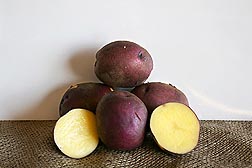Washington, DC, USA
October 24, 2012
Potatoes with higher levels of beneficial carotenoids are the result of U.S. Department of Agriculture (USDA) studies to improve one of America's most popular vegetables.
Scientists with USDA's Agricultural Research Service (ARS) bred yellow potatoes with carotenoid levels that are two to three times higher than those of the popular Yukon Gold yellow-fleshed potato variety.

Peter Wilcox potatoes. This yellow-fleshed, purple-skinned potato has overall carotenoid levels about 15 percent higher than Yukon Gold potatoes. Photo by University of Florida.
ARS plant geneticist Kathy Haynes and nutritionist Beverly Clevidence did the research at the agency's Henry A. Wallace Beltsville Agricultural Research Center in Beltsville, Md. Haynes works in the Genetic Improvement for Fruits and Vegetables Laboratory (GIFVL) at the Beltsville center, and Clevidence works in the center's Food Components and Health Laboratory. They published their findings in the Journal of the American Society for Horticultural Science.
ARS is USDA's principal intramural scientific research agency, and this research supports the USDA priority of promoting international food security.
Haynes found wild potatoes with intense yellow flesh that have about 23 times more carotenoids than white-flesh potatoes. By crossing these wild potatoes with cultivated types, Haynes and her colleagues developed the high-carotenoid potatoes.
In 2007, Haynes and her colleagues introduced a new potato named Peter Wilcox that they developed. The potato, which has purple skin and yellow flesh, has become popular in niche roadside markets. The overall carotenoid levels in this potato are more than 15 percent higher than those in Yukon Gold, according to Haynes.
Several carotenoids are involved, including neoxanthin, antheraxanthin, violaxanthin, lutein and zeaxanthin. Among these, lutein and zeaxanthin, are of keen interest for eye health; they appear to protect against age-related macular degeneration and perhaps against cataract formation.
Read more about this and other fruit and vegetable research in the October 2012 issue of Agricultural Research magazine.
Investigadores desarrollan papas que contienen niveles más altos de carotenoides
Papas que contienen niveles más altos de los carotenoides beneficiosos son el resultado de estudios por científicos del Servicio de Investigación Agrícola (ARS) para mejorar una de las hortalizas más populares en EE.UU.
Científicos del ARS han desarrollado papas con pulpa de color amarillo que contienen niveles de carotenoides que son dos a tres veces más altos que los de la papa popular 'Yukon Gold', que también tiene pulpa de color amarillo.
Genetista de plantas Kathy Haynes y dietista Beverly Clevidence realizaron los estudios en el Centro Henry A. Wallace de Investigación Agrícola mantenido por el ARS en Beltsville, Maryland. Haynes trabaja en el Laboratorio de Investigación del Mejoramiento Genético de Frutas y Hortalizas en el centro en Beltsville, y Clevidence trabaja en el Laboratorio de Componentes Alimenticios y Salud, también en el centro en Beltsville. Ellas publicaron sus hallazgos en 'Journal of the American Society for Horticultural Science' (Revista de la Sociedad Americana de Ciencia Hortícola).
ARS es la agencia principal de investigaciones científicas del Departamento de Agricultura de EE.UU. (USDA por sus siglas en inglés), y esta investigación apoya la prioridad del USDA de promover la seguridad alimentaria internacional.
Haynes descubrió algunas papas silvestres que tuvieron pulpa de color amarillo vivo y aproximadamente 23 veces más carotenoides que las papas que tienen pulpa de color blanco. Haynes y sus colegas cruzaron estas papas silvestres con variedades comerciales y de este modo desarrollaron las papas con niveles muy altos de carotenoides.
En el 2007, Haynes y sus colegas introdujeron una nueva variedad de papa llamada 'Peter Wilcox' que resultó de sus investigaciones. Esa papa, la cual tiene piel de color morado y pulpa de color amarillo, ha llegado a ser muy popular en los mercados de nicho. Los niveles totales de carotenoides en 'Peter Wilcox' son por lo menos 15 por ciento más altos que los en 'Yukon Gold', según Haynes.
Hay varios carotenoides en la papa, incluyendo neoxantina, anteraxantina, violaxantina, luteina y zeaxantina. Los expertos tienen un interés particular en el papel potencial de luteina y zeaxantina en la salud ocular. Parece que estos carotenoides podrían proteger contra la degeneración macular relacionada con la edad, y quizás contra la formación de las cataratas.
Lea más sobre esta investigación en la revista 'Agricultural Research' de octubre del 2012.